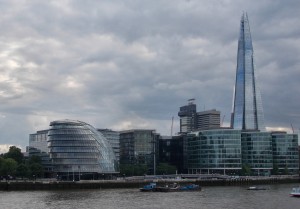
In the evening I went down to Tower Hill and walked across Tower Bridge to City Hall, where the London Orchard Project was celebrating its 5th Birthday.
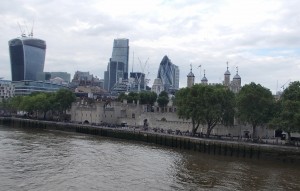
The amount of new development is a shock after the relative quiet of west London, but I had a strong feeling (presumably the City Hall architect’s intention) of being right at the centre of a great and bustling city. Across the river is the quiet symmetry and antique military splendour of the Tower of London: it’s even beautiful in its stern way. But right next to it is the bulging, up-thrusting, grey glass, steel and concrete disharmony of the City, former giants like the NatWest tower and the Gherkin already dwarfed by newer demonstrations of financial might, brazenly shoving their manhood up into the sky. It’s jarring.
But then, I reflected, there are Roman walls near the Tower and at the Barbican: this city is 2000 years old. It was already ancient when the Normans came and rudely shoved the White Tower with its four-square pinnacles and Might Makes Right foreign invaders’ pennants to fly high over a thoroughly defeated, despondent and disgusted Anglo-Saxon (i.e. English) nation.
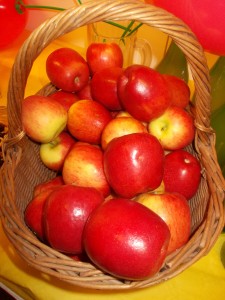
Once inside City Hall, after the brisk initiation with airport-style security (at least I didn’t have to remove shoes and belt), it was down and round the ridiculously long spiral ramp – what a grotesque waste of space compared to stairs and lifts, but how distinctive also (presumably city politics takes you round and round and never seems to get anywhere, hmm), I stumbled into a meeting room decked out with fruity bunting, maps, photographs, fruit juice, cider, apples, apple cake and bowls of dried fruit and nuts.
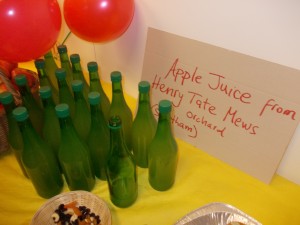
I learnt that London Orchard Project had been founded by two friends, Carina and Rowena, who had just realized that our parks didn’t have to consist of nothing but inedible London Plane trees and grass. They emailed a lot of people and within four days had 120 groups who wanted to join in! Since then, 12 old overgrown orchards have been saved and restored, and an extraordinary 83 new orchards have been planted all over our city: soon there will be 100. Even after 2000 years of urban growth and development, I reflected, there is still space and energy and enthusiasm and collegiality for a hundred beautiful spaces full of healthy, vigorous, productive fruit trees.
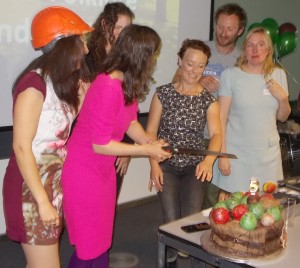
All the talks were remarkably interesting. Lewis McNeill gave practical tips for healthy fruit trees, from pruning to fertilising, and gave away root cuttings of Comfrey, a herb which grows vigorously and gathers minerals in its leaves, making it ideal as a mulch for Apple trees. London Glider cider-makers described their first few years, going from newbies to experts: unlike beer, which you make, sell, and then do the next batch, cider is made in the autumn, sold in the spring so you need a lot of storage: they do 7,000 litres a year, the limit before paying excise duty on every litre.
Amber Alferoff, a project manager (she’s on the right of the photo) spoke on the folklore of apples – all those fertility goddesses like Astarte/Ishtar, Aphrodite, Freya, Idunn and the Roman goddess Pomona (that was an easy one) have names that mean Apple, apparently, while Adam and Eve are offered the Apple by the Snake/Dragon, a combination that goes right back to ancient Babylon long before the bible, apparently.
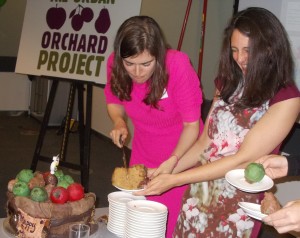
Carina and Rowena joined the celebrations by cutting the cake with a viciously sharp doubly-serrated 70-cm pruning saw (and the obligatory hard hat for tree work). There are 1200 volunteers; hundreds of Orchard Leaders; 50 public events; 3 tons of apples; a new apple variety, “Core Blimey”; and they even met the Queen. They worked fulltime for the project for a while but have now taken a well-deserved back seat as trustees.
In the driving seat now is Kath Rosen, Chief Executive, who spoke energetically about progress and the future, which most immediately is to start work in other cities including Manchester. That means the project has to be renamed to the Urban Orchard Project, as it’s no longer just London: growth indeed.
And Rich Sylvester, wearing quite a hat, told stories and made us sing an adapted version of ‘I’ve been a Wild Rover / For many a year’ only it was all about orchards.
But for me the most inspiring talk of the evening was given by the community team from the Orchard Estate in West Greenwich. The photographs told the story: a bleak estate of tall ugly brick-and-concrete towers surrounded by blank areas of grey concrete and dustbins. The residents never spoke to each other. Then in 2012 with the Olympics, money was on offer for a dozen projects, just a proposal was needed. They had a go and won: now there’s an outdoor gym area, popular with all ages; a large square of grass dotted with neatly mulched circles around handsome apple trees; and a veggie polytunnel and a dozen allotment plots, where neighbours come out to sit, chat and enjoy working together. The effect on wellbeing and genuine community (what an overused word that is) was immediate. Now the London Orchard Project has got them to act as tree nursery for the whole project, as they have enough land for it, and willing people too. When they said that now they were extending the orchard with more trees every year in a new area of the estate, there was cheerful and rightly appreciative applause. We learnt, too, that visits to other orchards were always enjoyable, always a time to learn more. The name “Orchard Estate” had come, by the way, from a real orchard that the concrete had destroyed, the architect soullessly naming each hideous tower after a kind of apple – Worcester Pearmain, Egremont Russet and so on. Now, full circle, a tree of each of those varieties has been planted: all but one, now uncommon, which is being sought. Life goes on, and together, if we work as a community, we really can be in harmony with nature and each other.
